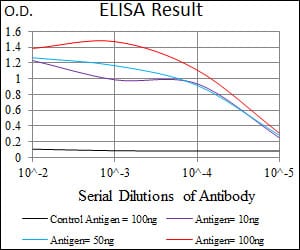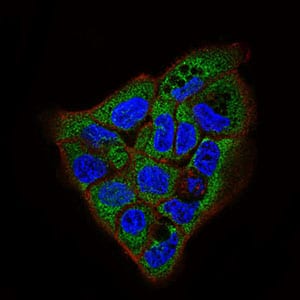

| WB | 咨询技术 | Human,Mouse,Rat |
| IF | 咨询技术 | Human,Mouse,Rat |
| IHC | 咨询技术 | Human,Mouse,Rat |
| ICC | 1/200 - 1/1000 | Human,Mouse,Rat |
| FCM | 咨询技术 | Human,Mouse,Rat |
| Elisa | 1/10000 | Human,Mouse,Rat |
| Aliases | AAA; AD1; PN2; ABPP; APPI; CVAP; ABETA; PN-II; CTFgamma |
| Entrez GeneID | 351 |
| clone | 3F12F6 |
| WB Predicted band size | 87kDa |
| Host/Isotype | Mouse IgG1 |
| Antibody Type | Primary antibody |
| Storage | Store at 4°C short term. Aliquot and store at -20°C long term. Avoid freeze/thaw cycles. |
| Species Reactivity | Human |
| Immunogen | Purified recombinant fragment of human APP (AA: 483-699) expressed in E. Coli. |
| Formulation | Purified antibody in PBS with 0.05% sodium azide. |
+ +
以下是关于APP抗体的3篇代表性文献摘要简述:
---
1. **文献名称**:Amyloid-β Immunotherapy for Alzheimer’s Disease
**作者**:Schenk, D., et al.
**摘要**:探讨抗Aβ抗体通过激活小胶质细胞清除脑内淀粉样斑块的机制,动物实验显示免疫疗法可减少转基因小鼠的病理沉积,为阿尔茨海默病治疗提供新方向。
---
2. **文献名称**:Targeting Amyloid-β Oligomers by Passive Immunization
**作者**:Sharman, M.J., et al.
**摘要**:研究发现针对APP不同表位的单克隆抗体(如6E10、4G8)对Aβ寡聚体清除效果差异显著,部分抗体可改善模型动物认知功能,提示表位特异性影响治疗效果。
---
3. **文献名称**:Passive Immunotherapy Against Aβ in APP Transgenic Mice
**作者**:Lemere, C.A., et al.
**摘要**:通过向APP/PS1转基因小鼠注射抗APP抗体,发现其能穿透血脑屏障并减少可溶性Aβ40/42水平,延缓神经突触损伤,支持被动免疫治疗的临床潜力。
---
如需具体文献年份或补充其他研究(如临床抗体药物aducanumab相关论文),可进一步调整。
APP (amyloid precursor protein) is a transmembrane glycoprotein highly expressed in the brain and involved in synaptic formation, neuronal plasticity, and intracellular signaling. Its proteolytic processing through amyloidogenic or non-amyloidogenic pathways plays a central role in Alzheimer’s disease (AD) pathogenesis. In the amyloidogenic pathway, sequential cleavage by β-secretase (BACE1) and γ-secretase generates neurotoxic amyloid-beta (Aβ) peptides, which aggregate into plaques—a hallmark of AD. APP-targeting antibodies have emerged as critical tools for both research and therapeutic exploration.
Research-grade APP antibodies are widely used to detect APP expression, localization, and processing in cellular and animal models (e.g., transgenic mice), as well as in human biofluids like cerebrospinal fluid (CSF). These antibodies often target specific APP epitopes (e.g., N-terminal, C-terminal, or Aβ domains) to distinguish full-length APP from its proteolytic fragments (e.g., sAPPα, sAPPβ, Aβ). Therapeutically, anti-Aβ antibodies (e.g., aducanumab, lecanemab) aim to clear Aβ plaques or neutralize soluble Aβ oligomers, with some achieving clinical approval despite ongoing debates over efficacy and safety. Other strategies include BACE1 inhibitors or antibodies targeting APP cleavage sites to modulate Aβ production. Challenges remain in optimizing blood-brain barrier penetration, minimizing off-target effects, and addressing the complex pathophysiology of AD beyond Aβ-centric approaches. APP antibodies thus represent a dual-purpose innovation, bridging mechanistic studies and therapeutic development in neurodegenerative research.
×